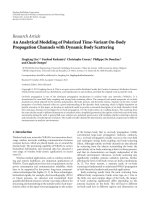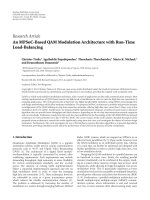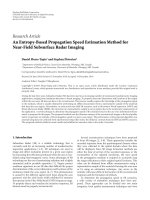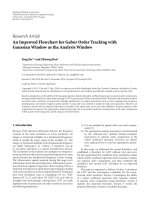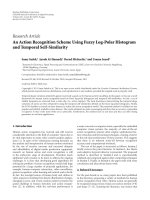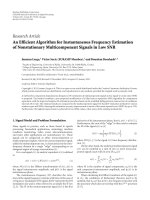Báo cáo hóa học: " Research Article An Optimal Double Inequality for Means Wei-Mao Qian and Ning-Guo Zheng" pptx
Bạn đang xem bản rút gọn của tài liệu. Xem và tải ngay bản đầy đủ của tài liệu tại đây (487.28 KB, 11 trang )
Hindawi Publishing Corporation
Journal of Inequalities and Applications
Volume 2010, Article ID 578310, 11 pages
doi:10.1155/2010/578310
Research Article
An Optimal Double Inequality for Means
Wei-Mao Qian and Ning-Guo Zheng
Huzhou Broadcast and TV University, Huzhou 313000, China
Correspondence should be addressed to Wei-Mao Qian,
Received 3 September 2010; Accepted 27 September 2010
Academic Editor: Alberto Cabada
Copyright q 2010 W M. Qian and N G. Zheng. This is an open access article distributed under
the Creative Commons Attribution License, which permits unrestricted use, distribution, and
reproduction in any medium, provided the original work is properly cited.
For p ∈
R, the generalized logarithmic mean L
p
a, b, arithmetic mean Aa, b and geometric
mean Ga, b of two positive numbers a and b are defined by L
p
a, ba, a b; L
p
a, b
a
p1
− b
p1
/p 1a − b
1/p
, p
/
0, p
/
− 1, a
/
b; L
p
a, b1/eb
b
/a
a
1/b−a
, p 0, a
/
b;
L
p
a, bb − a/ln b −ln a, p −1, a
/
b; Aa, ba b/2andGa, b
√
ab, respectively. In
this paper, we give an answer to the open problem: for α ∈ 0, 1, what are the greatest value p and
the least value q, such that the double inequality L
p
a, b ≤ G
α
a, bA
1−α
a, b ≤ L
q
a, b holds for
all a, b > 0?
1. Introduction
For p ∈ R, the generalized logarithmic mean L
p
a, b of two positive numbers a and b is
defined by
L
p
a, b
⎧
⎪
⎪
⎪
⎪
⎪
⎪
⎪
⎪
⎪
⎪
⎪
⎪
⎪
⎪
⎪
⎨
⎪
⎪
⎪
⎪
⎪
⎪
⎪
⎪
⎪
⎪
⎪
⎪
⎪
⎪
⎪
⎩
a, a b,
a
p1
− b
p1
p 1
a − b
1/p
,p
/
0 ,p
/
− 1,a
/
b,
1
e
b
b
a
a
1/b−a
,p 0 ,a
/
b,
b − a
ln b − ln a
,p −1,a
/
b.
1.1
It is wellknown that L
p
a, b is continuous and increasing with respect to p ∈ R for
fixed a and b. In the recent past, the generalized logarithmic mean has been the subject of
2 Journal of Inequalities and Applications
intensive research. Many remarkable inequalities and monotonicity results can be found
in the literature 1–9. It might be surprising that the generalized logarithmic mean, has
applications in physics, economics, and even in meteorology 10–13.
If we denote by Aa, bab/2,Ia, b1/eb
b
/a
a
1/b−a
, La, bb−a/ln b−
ln a,Ga, b
√
ab and Ha, b2ab/ab the arithmetic mean, identric mean, logarithmic
mean, geometric mean and harmonic mean of two positive numbers a and b, respectively,
then
min
{
a, b
}
≤ H
a, b
≤ G
a, b
L
−2
a, b
≤ L
a, b
L
−1
a, b
≤ I
a, b
L
0
a, b
≤ A
a, b
L
1
a, b
≤ max
{
a, b
}
.
1.2
For p ∈ R,thepth power mean M
p
a, b of two positive numbers a and b is defined by
M
p
a, b
⎧
⎪
⎪
⎨
⎪
⎪
⎩
a
p
b
p
2
1/p
,p
/
0,
√
ab, p 0.
1.3
In 14, Alzer and Janous established the following sharp double inequality see also
15, Page 350:
M
log 2/ log 3
a, b
≤
2
3
A
a, b
1
3
G
a, b
≤ M
2/3
a, b
1.4
for all a, b > 0.
For α ∈ 0, 1, Janous 16 found the greatest value p and the least value q such that
M
p
a, b
≤ αA
a, b
1 − α
G
a, b
≤ M
q
a, b
1.5
for all a, b > 0.
In 17–19 the authors present bounds for La, b and Ia, b in terms of Ga, b and
Aa, b.
Theorem A. For all positive real numbers a and b with a
/
b, one has
L
a, b
<
1
3
A
a, b
2
3
G
a, b
,
1
3
G
a, b
2
3
A
a, b
<I
a,b
.
1.6
The proof of the following Theorem B can be found in 20 .
Journal of Inequalities and Applications 3
Theorem B. For all positive real numbers a and b with a
/
b, one has
G
a, b
A
a, b
<
L
a, b
I
a, b
<
1
2
L
a, b
I
a, b
<
1
2
G
a, b
A
a, b
.
1.7
The following Theorems C–E were established by Alzer and Qiu in 21.
Theorem C. The inequalities
αA
a, b
1 − α
G
a, b
<I
a, b
<βA
a, b
1 − β
G
a, b
1.8
hold for all positive real numbers a and b with a
/
b if and only if α ≤ 2/3 and β ≥ 2/e 0.73575
Theorem D. Let a and b be real numbers with a
/
b.If0 <a, b≤ e,then
G
a, b
Aa,b
<
L
a, b
Ia,b
<
A
a, b
Ga,b
.
1.9
And if a, b ≥ e, then
A
a, b
Ga,b
<
I
a, b
La,b
<
G
a, b
Aa,b
.
1.10
Theorem E. For all real numbers a and b with a
/
b, one has
M
p
a, b
<
1
2
L
a, b
I
a, b
1.11
with the best possible parameter p log 2/1 log 20.40938
However, the following problem is still open: for α ∈ 0, 1, what are the greatest value
p and the least value q, such that the double inequality
L
p
a, b
≤ G
α
a, b
A
1−α
a, b
≤ L
q
a, b
1.12
holds for all a, b > 0? The purpose of this paper is to give the solution to this open problem.
2. Lemmas
In order to establish our main result, we need two lemmas, which we present in this section.
Lemma 2.1. If t>1,then
t
t − 1
log t −
1
6
log t −
2
3
log
1 t
2
− 1 > 0. 2.1
4 Journal of Inequalities and Applications
Proof. Let ftt/t−1 log t−1/6 log t−2/3 log1t/2−1, then simple computation
yields
lim
t →1
f
t
0,
2.2
f
t
g
t
6t
t − 1
2
t 1
,
2.3
where
g
t
t
3
9t
2
− 9t − 6t
t 1
log t − 1,
g
1
0,
g
t
3t
2
12t − 6
2t 1
log t − 15,
g
1
0,
g
t
6
t
h
t
,
2.4
where
h
t
t
2
− 2t log t − 1,
g
1
h
1
0,
2.5
h
t
2
t − log t − 1
,
h
1
0,
2.6
h
t
2
1 −
1
t
. 2.7
If t>1, then from 2.7 we clearly see that
h
t
> 0. 2.8
Therefore, Lemma 2.1 follows from 2.3–2.6 and 2.8.
Lemma 2.2. If t>1,then
log
t − 1
− log
log t
−
1
3
log
t
2
t
1
3
log 2 > 0. 2.9
Journal of Inequalities and Applications 5
Proof. Let ftlogt −1 −loglog t −1/3 logt
2
t1/3 log 2, then simple computation
leads to
lim
t →1
f
t
0,
f
t
g
t
3t
t − 1
t 1
log t
,
2.10
where
g
t
t
2
4t 1
log t − 3t
2
3,
g
1
0,
g
t
h
t
t
,
2.11
where
h
t
2t
t 2
log t − 5t
2
4t 1,
g
1
h
1
0,
h
t
4
t 1
log t − 8t 8,
h
1
0,
h
t
4
t
p
t
,
2.12
where
p
t
t log t − t 1,
h
1
p
1
0,
2.13
p
t
log t. 2.14
If t>1, then from 2.14 we clearly see that
p
t
> 0. 2.15
From 2.10–2.13 and 2.15 we know that ft > 0fort>1.
3. Main Results
Theorem 3.1. If α ∈ 0, 1,thenG
α
a, bA
1−α
a, b ≤ L
1−3α
a, b for all a, b > 0, with equality if
and only if a b, and the constant 1 − 3α in L
1−3α
a, b, cannot be improved.
6 Journal of Inequalities and Applications
Proof. If a b, then we clearly see that G
α
a, bA
1−α
a, bL
1−3α
a, ba.
If a
/
b, without loss of generality, we assume that a>b.Lett a/b > 1and
f
t
log L
1−3α
a, b
− log
G
α
a, b
A
1−α
a, b
. 3.1
Firstly, we prove G
α
a, bA
1−α
a, b <L
1−3α
a, b. The proof is divided into three cases.
Case 1. α 1/3. We note that 1.1 leads to the following identity:
f
t
t
t − 1
log t −
1
6
log t −
2
3
log
1 t
2
− 1.
3.2
From 3.2 and Lemma 2.1 we clearly see that L
1−3α
a, b >G
α
a, bA
1−α
a, b for α
1/3anda
/
b.
Case 2. α 2/3. Equation 1.1 leads to the following identity:
f
t
log
t − 1
− log
log t
−
1
3
log
t
2
t
1
3
log 2.
3.3
From 3.3 and Lemma 2.2 we clearly see that L
1−3α
a, b >G
α
a, bA
1−α
a, b for α 2/3and
a
/
b.
Case 3. α ∈ 0, 1 \{1/3, 2/3}.From1.1 we have the following identity:
f
t
1
1 − 3α
log
t
2−3α
− 1
2 − 3α
t − 1
−
α
2
log t −
1 − α
log
1 t
2
.
3.4
Equation 3.4 and elementary computation yields
lim
t →1
f
t
0,
3.5
f
t
1
t
t
2
− 1
t
2−3α
− 1
g
t
,
3.6
Journal of Inequalities and Applications 7
where
g
t
α
2
t
4−3α
−
α
4 − 3α
1 − 3α
t
3−3α
−
1 − α
4 − 3α
2
1 − 3α
t
2−3α
1 − α
4 − 3α
2
1 − 3α
t
2
α
4 − 3α
1 − 3α
t −
α
2
.
g
1
0,
g
t
α
4 − 3α
2
t
3−3α
−
3α
4 − 3α
1 − α
1 − 3α
t
2−3α
−
1 − α
4 − 3α
2 − 3α
2
1 − 3α
t
1−3α
1 − α
4 − 3α
1 − 3α
t
α
4 − 3α
1 − 3α
,
g
1
0,
g
t
3α
4 − 3α
1 − α
2
t
2−3α
−
3α
4 − 3α
2 − 3α
1 − α
1 − 3α
t
1−3α
−
1 − α
4 − 3α
2 − 3α
2
t
−3α
1 − α
4 − 3α
1 − 3α
,
g
1
0,
3.7
g
t
3α
4 − 3α
1 − α
2 − 3α
2t
3α1
t − 1
2
. 3.8
If α ∈ 0, 1 \{1/3, 2/3}, then 3.8 implies
g
t
> 0 3.9
for t>1. Therefore, ft > 0 follows from 3.5–3.7 and 3.9.
If α ∈ 2/3, 1, then 3.8 leads to
g
t
< 0 3.10
for t>1. Therefore, ft > 0 follows from 3.5–3.7 and 3.10.
Next, we prove that the constant 1−3α in the inequality G
α
a, bA
1−α
a, b ≤ L
1−3α
a, b
cannot be improved. The proof is divided into five cases.
Case 1. α 1/3. For any ∈ 0, 1,letx ∈ 0, 1, then 1.1 leads to
G
1/3
1, 1 x
A
2/3
1, 1 x
−
L
−
1, 1 x
f
1
x
1 x
1−
− 1
,
3.11
where f
1
x1 x
1/6
1 x/2
2/3
1 x
1−
− 1 − 1 − x.
8 Journal of Inequalities and Applications
Making use of Taylor expansion we get
f
1
x
1
6
x −
6 −
72
x
2
o
x
2
1
3
x −
3 − 2
36
x
2
o
x
2
×
1 −
x
1 −
2
x
1
6
x
2
o
x
2
−
1 −
x
2
1 −
24
x
3
o
x
3
.
3.12
Case 2. α 2/3. For any >0, let x ∈ 0, 1, then
G
2/3
1, 1 x
A
1/3
1, 1 x
1
−
L
−1−
1, 1 x
1
f
2
x
1 x
− 1
,
3.13
where f
2
x1 x
− 11 x
1/3
1 x/2
1/3
− x1 x
.
Using Taylor expansion we have
f
2
x
x
1 −
1 −
2
x
1 −
2 −
6
x
2
o
x
2
×
1
1
3
x −
1
2 −
18
x
2
o
x
2
×
1
1
6
x −
1
2 −
72
x
2
o
x
2
−
1 x −
1 −
2
x
2
o
x
2
2
1
24
x
3
o
x
3
.
3.14
Case 3. α ∈ 0, 1/3. For any ∈ 0, 1 − 3α,letx ∈ 0, 1, then
G
α
1, 1 x
A
1−α
1, 1 x
1−3α−
−
L
1−3α−
1, 1 x
1−3α−
f
3
x
2 − 3α −
x
, 3.15
where f
3
x2 − 3α − x1 x
α1−3α−/2
1 x/2
1−α1−3α−
− 1 x
2−3α−
− 1.
Making use of Taylor expansion and elaborated calculation we have
f
3
x
24
1 − 3α −
2 − 3α −
x
3
o
x
3
. 3.16
Journal of Inequalities and Applications 9
Case 4. α ∈ 1/3, 2/3. For any ∈ 0, 2 − 3α,letx ∈ 0, 1, then
G
α
1, 1 x
A
1−α
1, 1 x
3α−1
−
L
1−3α−
1, 1 x
3α−1
f
4
x
1 x
2−3α−
− 1
, 3.17
where f
4
x1 x
2−3α−
− 11 x
α3α−1/2
1 x/2
1−α3α−1
− 2 − 3α − x.
Using Taylor expansion and elaborated calculation we have
f
4
x
24
3α − 1
2 − 3α −
x
3
o
x
3
. 3.18
Case 5. α ∈ 2/3, 1. For any >0, let x 0, 1, then
G
α
1, 1 x
A
1−α
1, 1 x
3α−1
−
L
1−3α−
1, 1 x
3α−1
f
5
x
1 x
3α−2
− 1
,
3.19
where f
5
x1 x
3α−2
−11 x
α3α−1/2
1 x/2
1−α3α−1
−3α−2x1 x
3α−2
.
Using Taylor expansion and elaborated calculation we get
f
5
x
24
3α − 1
3α − 2
x
3
o
x
3
.
3.20
Cases 1–5 show that for any α ∈ 0, 1, there exists
0
0
α > 0, for any ∈ 0,
0
there exists δ δα, > 0 such that L
1−3α−
1, 1 x <G
α
1, 1 xA
1−α
1, 1 x for x ∈
0,δ.
Theorem 3.2. If α ∈ 0, 1,thenG
α
a, bA
1−α
a, b ≥ L
2/α−2
a, b for all a, b > 0, with equality if
and only if a b, and the constant 2/α − 2 in L
2/α−2
a, b cannot be improved.
Proof. If a b, then we clearly see that G
α
a, bA
1−α
a, bL
2/α−2
a, ba.
If a
/
b, without loss of generality, we assume that a>b.Lett a/b > 1and
f
t
log L
2/α−2
a, b
− log
G
α
a, b
A
1−α
a, b
. 3.21
Firstly, we prove ft < 0fort a/b > 1. Simple computation leads to
f
t
α − 2
2
log
t
α/α−2
− 1
α/
α − 2
t − 1
−
α
2
log t −
1 − α
log
1 t
2
,
lim
t →1
f
t
0,
f
t
g
t
t
t − 1
t 1
t
α/α−2
− 1
,
3.22
10 Journal of Inequalities and Applications
where
g
t
α
2
t
3α−4/α−2
4 − 3α
2
t
2α−1/α−2
−
4 − 3α
2
t −
α
2
.
g
1
0,
g
t
α
3α − 4
2
α − 2
t
2α−1/α−2
α − 1
4 − 3α
α − 2
t
α/α−2
−
4 − 3α
2
,
g
1
0,
g
t
α
4 − 3α
1 − α
α − 2
2
t
2/α−2
t − 1
> 0
3.23
for t>1andα ∈ 0, 1.
From 3.23 we clearly see that
g
t
> 0 3.24
for t>1.
Since α/α − 2 < 0, we have tt − 1t 1t
α/α−2
− 1 < 0fort ∈ 1, ∞. Therefore,
ft < 0 follows from 3.22 and 3.24.
Next, we prove that the constant 2/α − 2 cannot be improved.
For any ∈ 0,α/2 − α, we have
L
2/α−2
1,t
2/2−α−
−
G
α
1,t
A
1−α
1,t
2/2−α−
t
α/
2 − α
−
1 −
1/t
1 − t
−α/2−α−
− t
−2−α/2
1
1/t
2
1−α2/2−α−
,
lim
t →∞
α/
2 − α
−
1 −
1/t
1 − t
−α/2−α−
− t
−2−α/2
1
1/t
2
1−α2/2−α−
α
2 − α
− .
3.25
Equation 3.25 imply that for any ∈ 0,α/2 − α there exists T T, α > 1, such
that L
2/α−2
1,t >G
α
1,tA
1−α
1,t for t ∈ T, ∞.
Acknowledgment
This work was supported by the Natural Science Foundation of Zhejiang Broadcast and TV
University Grant no. XKT-09G21.
Journal of Inequalities and Applications 11
References
1 K. B. Stolarsky, “The power and generalized logarithmic means,” The American Mathematical Monthly,
vol. 87, no. 7, pp. 545–548, 1980.
2 C. E. M. Pearce and J. Pe
ˇ
cari
´
c, “Some theorems of Jensen type for generalized logarithmic means,”
Revue Roumaine de Math
´
ematiques Pures et Appliqu
´
ees, vol. 40, no. 9-10, pp. 789–795, 1995.
3 B. Mond, C. E. M. Pearce, and J. Pe
ˇ
cari
´
c, “The logarithmic mean is a mean,” Mathematical
Communications, vol. 2, no. 1, pp. 35–39, 1997.
4 Ch P. Chen and F. Qi, “Monotonicity properties for generalized logarithmic means,” The Australian
Journal of Mathematical Analysis and Applications, vol. 1, no. 2, article 2, pp. 1–4, 2004.
5 W F. Xia, Y M. Chu, and G D. Wang, “The optimal upper and lower power mean bounds for a
convex combination of the arithmetic and logarithmic means,” Abstract and Applied Analysis, vol. 2010,
Article ID 604804, 9 pages, 2010.
6 B Y. Long and Y M. Chu, “Optimal inequalities for generalized logarithmic, arithmetic, and
geometric means,” Journal of Inequalities and Applications, vol. 2010, Article ID 806825, 10 pages, 2010.
7 Y M. Chu and W F. Xia, “Inequalities for generalized logarithmic means,” Journal of Inequalities and
Applications, vol. 2009, Article ID 763252, 7 pages, 2009.
8 Ch P. Chen, “The monotonicity of the ratio between generalized logarithmic means,” Journal of
Mathematical Analysis and Applications, vol. 345, no. 1, pp. 86–89, 2008.
9 F. Qi, X A. Li, and S X. Chen, “Refinements, extensions and generalizations of the second Kershaw’s
double inequality,” Mathematical Inequalities & Applications, vol. 11, no. 3, pp. 457–465, 2008.
10 P. Kahlig and J. Matkowski, “Functional equations involving the logarithmic mean,” Zeitschrift f
¨
ur
Angewandte Mathematik und Mechanik, vol. 76, no. 7, pp. 385–390, 1996.
11 A. O. Pittenger, “The logarithmic mean in n variables,” The American Mathematical Monthly, vol. 92,
no. 2, pp. 99–104, 1985.
12 N. S. Nadirashvili, “New isoperimetric inequalities in mathematical physics,” in Partial Differential
Equations of Elliptic Type (Cortona, 1992)
, Sympos. Math., XXXV, pp. 197–203, Cambridge University
Press, Cambridge, UK, 1994.
13 G. P
´
olya and G. Szeg
¨
o, Isoperimetric Inequalities in Mathematical Physics, Annals of Mathematics
Studies, no. 27, Princeton University Press, Princeton, NJ, USA, 1951.
14 H. Alzer and W. Janous, “Solution of problem 8
∗
,” Crux Mathematicorum, vol. 13, pp. 173–178, 1987.
15 P. S. Bullen, D. S. Mitrinovi
´
c,andP.M.Vasi
´
c, Means and Their Inequalities, vol. 31 of Mathematics and
Its Applications (East European Series), D. Reidel, Dordrecht, The Netherlands, 1988.
16 W. Janous, “A note on generalized Heronian means,” Mathematical Inequalities & Applications, vol. 4,
no. 3, pp. 369–375, 2001.
17 B. C. Carlson, “The logarithmic mean,” The American Mathematical Monthly, vol. 79, pp. 615–618, 1972.
18 E. B. Leach and M. C. Sholander, “Extended mean values. II,” Journal of Mathematical Analysis and
Applications, vol. 92, no. 1, pp. 207–223, 1983.
19 J. S
´
andor, “A note on some inequalities for means,” Archiv der Mathematik, vol. 56, no. 5, pp. 471–473,
1991.
20 H. Alzer, “Ungleichungen f
¨
ur Mittelwerte,” Archiv der Mathematik, vol. 47, no. 5, pp. 422–426, 1986.
21 H. Alzer and S L. Qiu, “Inequalities for means in two variables,” Archiv der Mathematik, vol. 80, no.
2, pp. 201–215, 2003.




